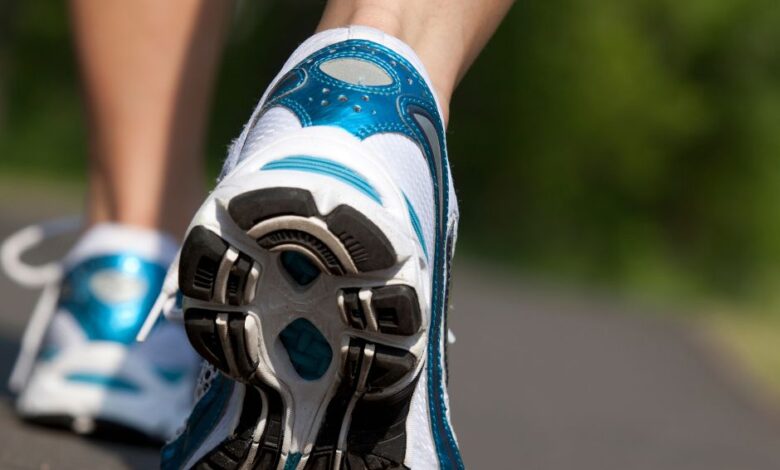
Finding the best walking shoes can feel overwhelming with so many choices. To make a good choice, it’s key to know what makes a shoe great for walking. You need to think about your foot type and how you walk. This article will give you expert advice on picking the right walking shoes for comfort and performance.
Knowing how to pick the best walking shoes is vital for a comfy walk. Our guide will help you choose wisely, making your walks better. Whether you walk for fun or exercise, finding the right shoes is crucial.
Introduction to Finding the Best Walking Shoes
We aim to help you find the perfect walking shoes for your needs. With the right info, you’ll confidently find shoes that fit your requirements. By the end of this article, you’ll know how to choose the best walking shoes for you.
Key Takeaways
- Learn how to find the best walking shoes by considering your foot type and walking style
- Understand the key features of quality walking shoes
- Discover how to find the best walking shoes for your specific needs
- Make a smart investment in your walking shoes
- Improve your overall walking experience with the right shoes
- Find the best walking shoes by following our expert tips and guidelines
Understanding Why Proper Walking Shoes Matter
Having the right shoes for walking can change your experience a lot. A good walking shoe buying guide helps you pick shoes that support and cushion your feet well. This is key for your joint health.
Proper walking shoes can lower injury risks and boost your walking performance. They make walking more efficient and enjoyable.
A walking shoe buying guide stresses the need for a snug fit and good traction. This prevents blisters and sprains. The right shoes let you walk longer without getting tired. They make your walks more comfortable and safe.
Whether you walk casually or hike a lot, getting the right shoes is crucial. It’s important for your health and well-being.
We’ll explore the important features of quality walking shoes next. We’ll also share tips on finding the best shoes for your foot type. By using a reliable walking shoe buying guide, you can make smart choices. This ensures you find the perfect shoes for your walking needs.
Proper walking shoes greatly affect your joint health, walking efficiency, and performance. By picking the right shoes, you can avoid injuries. You’ll also enjoy a more comfortable and safe walking experience. Always refer to a walking shoe buying guide to make the best choice for your walking needs.
Key Features of Quality Walking Shoes
When looking for the best shoes for walking, there are key features to keep in mind. A comfortable and breathable upper material is important. It keeps your feet cool and dry.
A supportive and cushioned midsole is also crucial. It offers comfort and absorbs shock for a smooth walk. A durable outsole with good traction is vital too. It keeps you stable and prevents slipping on different surfaces.
Lastly, a secure fit with adjustable lacing and a padded collar is essential. It ensures your feet stay comfortable and secure. These features are key for a comfortable and supportive walk.
Investing in quality walking shoes with these features makes walking more enjoyable. Whether you walk for fitness, fun, or to get around, the right shoes matter. With the right fit and features, you can walk with confidence and enjoy the benefits of walking.
How to Find the Best Walking Shoes for Your Foot Type
Choosing the right walking shoes starts with knowing your foot type. This is key for support and comfort. You need to look at your arch type and how your foot pronates.
Arch type is very important. There are flat feet, high arches, and neutral arches. Each needs a specific shoe for the best support and comfort. For instance, flat feet need more support, while high arches need more cushioning.
Knowing your pronation is also crucial. Pronation is how your foot rolls when walking or running. There are three types: neutral, overpronation, and underpronation. Neutral is the most common, where the foot rolls slightly inward.
Determining Your Arch Type
To find your arch type, try the “wet test.” Wet your feet and stand on a flat surface. If your footprint shows your whole foot, you have flat feet. If it shows a small impression with a curve, you have high arches.
Understanding Pronation
Knowing your pronation helps pick the right shoes. For overpronation, you need shoes with extra support to stop the foot from rolling too much.
Essential Comfort and Fit Considerations
When picking out walking shoes, think about comfort and fit. A great walking shoe should feel comfy and let your feet breathe. It should also support and cushion your feet well. To get the right fit, try on shoes in the afternoon when your feet are biggest. Wear the same socks you’ll wear while walking.
Comfort is crucial for walking shoes. Look for soft, breathable materials that keep your feet cool and dry. The midsole should be supportive and cushioned, absorbing shock and supporting your feet. A secure fit is also key, with a system that adjusts comfortably.
When trying on shoes, walk around the store to check comfort and support. Notice any discomfort or pressure spots. If needed, ask for a different size or style. By focusing on these comfort and fit points, you’ll find the perfect walking shoes. They’ll make your feet happy and healthy.
Understanding Walking Shoe Technologies
Finding the best walking shoes means knowing about the tech inside them. A good guide talks about cushioning, support, and how shoes breathe. These features make walking comfy and safe.
Shoe makers have come up with cool solutions for walkers. They use gel cushioning, air cushioning, and foam cushioning to soften each step. They also add arch and ankle support to keep you stable and injury-free.
Cushioning Systems
Cushioning is key in walking shoes. It lessens the shock of each step. Knowing how to pick the right cushioning is vital for a comfy and safe walk.
Support Mechanisms
Support is crucial for stability and injury prevention. A good guide will highlight the importance of arch and ankle support. These features help avoid common walking injuries.
Breathability Features
Breathability keeps your feet cool and dry. Features like mesh panels and ventilation systems are essential. They make walking more comfortable and healthy. When choosing shoes, don’t forget about breathability for your foot health.
When to Replace Your Walking Shoes
Knowing when to replace your walking shoes is key for a comfy and safe walk. Proper walking shoe selection is vital. You need to watch for wear and tear signs to know when it’s time for new shoes. The best shoes for walking offer support and cushioning, but they don’t last forever.
When picking walking shoes, think about their average life span. It can be from 300 to 500 miles, based on the shoe type and how you walk. Things like midsole compression and outsole wear also play a role in how long your shoes last.
Signs of Wear and Tear
Look out for signs like too much heel wear, midsole compression, and outsole wear. Walking shoe selection tips also suggest checking the tread and looking for uneven wear.
Optimal Replacement Timeline
The best time to replace your walking shoes depends on your walking habits and the shoe type. Generally, replace them every 6-12 months or after a certain number of miles. By following these walking shoe selection tips and picking the best shoes for walking, you’ll stay comfortable and safe while walking.
Price vs. Quality: Making Smart Investments
When buying walking shoes, the price doesn’t always show the quality. Look at materials, technology, and the brand’s reputation. A walking shoe buying guide can help you find the right shoes for you.
It’s important to know how to pick shoes that are both good and affordable. Search for shoes made with durable materials, good support, and cushioning. Think about how often and how far you walk to decide on the quality you need.
For example, if you walk a lot, you might want shoes with motion control or orthotic support.
A good walking shoe buying guide will tell you to try on shoes and walk around. This ensures they fit well. Don’t choose shoes just because they’re trendy or cheap. Look for ones that fit your needs.
To make a smart choice in walking shoes, do your research, be patient, and know what you need. By using a reliable how to choose walking shoes guide, you can find the perfect pair. They will support your walks and keep your feet comfortable for a long time.
Common Walking Shoe Shopping Mistakes to Avoid
When looking for walking shoe selection tips, many people miss important details. These details can make a big difference in how comfortable and safe your shoes are. One big mistake is picking the wrong size. This can lead to blisters, pain, and make walking harder.
Another error is not giving your feet time to get used to new shoes. How to find the best walking shoes also means thinking about where and how often you walk. Don’t just look for the cheapest option, as this can lead to poor-quality shoes that might harm your feet.
To steer clear of these mistakes, try on shoes and walk around the store. Think about arch support, cushioning, and how well they breathe. By paying attention to these walking shoe selection tips, you can find shoes that are both comfortable and supportive. Remember, good shoes are key to keeping your feet healthy and happy, so don’t settle for less.
Conclusion: Steps to Walking Shoe Success
Finding the right walking shoes is a journey. It needs careful thought about what you need and like. Knowing about fit, quality, and new shoe tech helps you choose well. This keeps your feet comfy and your walk smooth.
Always try shoes on and walk around to check the fit. Reviews from walkers can give you good info on shoe quality. Talking to a shoe fitter or walking expert is also key. They help find the best shoes for your feet and how active you are.
With the right shoes, walking gets even better. You’ll see better joint health, more endurance, and less injury risk. So, put on your shoes, go for a walk, and start enjoying better comfort and performance.
FAQ
What are the key features to look for in quality walking shoes?
Quality walking shoes should have a comfy and breathable upper. They should also have a supportive midsole and a durable outsole. A secure fit is key, with adjustable lacing and a padded collar.
How do I determine my foot type and choose the right walking shoes for it?
First, figure out your arch type and pronation. There are shoes for neutral, stability, and motion control. A shoe fitter can help you pick the right ones.
What comfort and fit considerations are important when choosing walking shoes?
Comfort and fit are crucial. Look for a shoe with a comfy upper and supportive midsole. Make sure it fits well, especially in the afternoon with the same socks you’ll wear while walking.
What walking shoe technologies should I look for?
Modern walking shoes have advanced tech like gel and air cushioning. They also have arch and ankle support, and are breathable. Look for mesh panels and ventilation systems.
How often should I replace my walking shoes?
It’s important to know when to replace your shoes. Watch for wear like heel and midsole compression. Walking shoes last about 300-500 miles, depending on how much you walk and where.
How can I make smart investments when purchasing walking shoes?
Don’t just look at price. Consider materials, technology, and brand. Think about how often and how far you walk. Find shoes that balance quality and price for a great walking experience.
What are some common walking shoe shopping mistakes to avoid?
Avoid size errors and ignoring the break-in period. Don’t sacrifice comfort for a low price. Try on shoes, wear them around, and think about your walking needs
View more every day health beauty skincre



